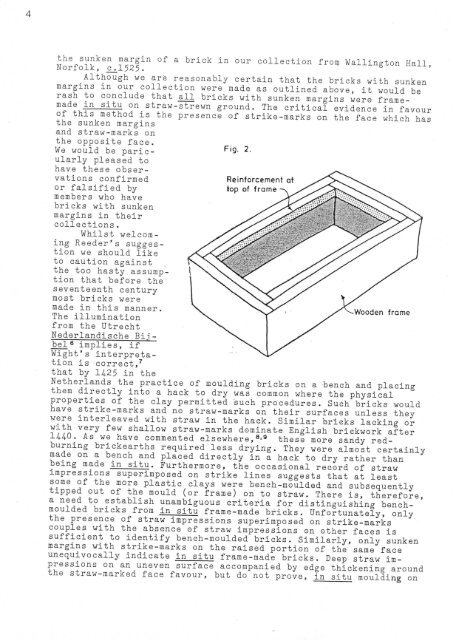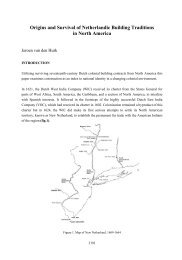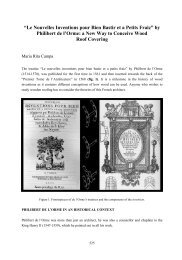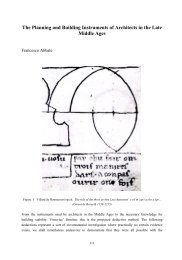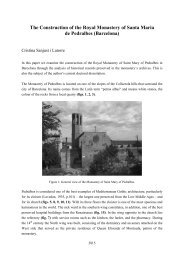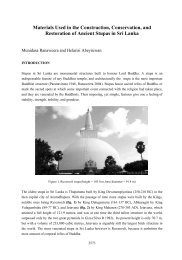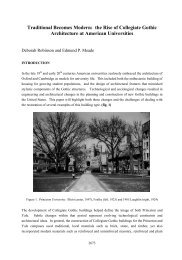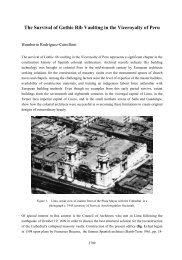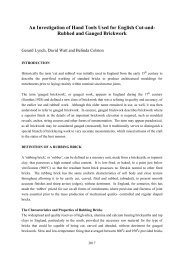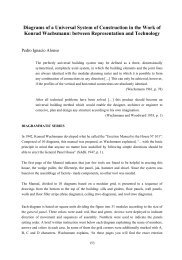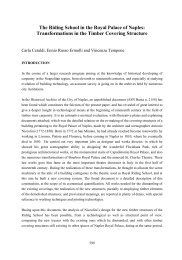bricks from the - Department of Architecture
bricks from the - Department of Architecture
bricks from the - Department of Architecture
Create successful ePaper yourself
Turn your PDF publications into a flip-book with our unique Google optimized e-Paper software.
4<br />
<strong>the</strong> sunken margin <strong>of</strong> a brick in our collection fro~ Wallington Hall,<br />
Norfolk, c.1525.<br />
Although we are reasonably certain that <strong>the</strong> <strong>bricks</strong> with sunken<br />
margins in our collection were made as outlined above, it would be<br />
rash to conclude that all <strong>bricks</strong> with sunken margins were framemade<br />
in situ on straw-strewn ground. The critical evidence in favour<br />
<strong>of</strong> this method is <strong>the</strong> presence <strong>of</strong> strika-marks on <strong>the</strong> face which has<br />
<strong>the</strong> sunken margins<br />
and straw-marks on<br />
<strong>the</strong> opposite face.<br />
We would be paricularly<br />
pleased to<br />
Fig. 2.<br />
have <strong>the</strong>se observations<br />
confirmed<br />
or falsified by<br />
members who have<br />
<strong>bricks</strong> with sunken<br />
margins in <strong>the</strong>ir<br />
collections.<br />
Whilst welcoming<br />
Reeder's suggestion<br />
we should like<br />
to caution against<br />
<strong>the</strong> too hasty assumption<br />
that before <strong>the</strong><br />
Reinforcement<br />
top <strong>of</strong> frame<br />
seventeenth century<br />
most <strong>bricks</strong> were<br />
made in this manner.<br />
The illumination<br />
<strong>from</strong> <strong>the</strong> Utrecht<br />
Nederlandis~he Bijbe1<br />
6 implies, if<br />
Wight's interpretation<br />
is 'correct,7<br />
that by 1425 in <strong>the</strong> .<br />
Ne<strong>the</strong>rlands <strong>the</strong> practice <strong>of</strong> moulding <strong>bricks</strong> on a bench and placing<br />
<strong>the</strong>m directly into a hack to dry was common where <strong>the</strong> physical<br />
properties <strong>of</strong> <strong>the</strong> clay permitted such procedures. Such <strong>bricks</strong> would<br />
have strike-marks and no straw-marks on <strong>the</strong>ir surfaces unless <strong>the</strong>y<br />
were interleaved with straw in <strong>the</strong> hack. Similar brieks lacking or<br />
with very few shallow straw-marks dominat.a English brickwork after<br />
1440. As we have commented elsewhere,8,9 <strong>the</strong>se more sandy redburning<br />
brickearths required'less drying~ They were almost certainly<br />
made on a bench and placed directly in a hack to dry ra<strong>the</strong>r than<br />
being made in situ. Fur<strong>the</strong>rrnare, <strong>the</strong> occasional record <strong>of</strong> straw<br />
impressions superimposed on strike linessuggests that at least<br />
some <strong>of</strong> <strong>the</strong> more plastic clays were bench-moulded and subsequently<br />
tipped out <strong>of</strong> <strong>the</strong> mould (or frame) on to straw. There is, <strong>the</strong>refore,<br />
a need to establish unambiguous criteria for distinguishing benchmoulded<br />
<strong>bricks</strong> <strong>from</strong> in s~tu frame-made b~icks. Unfortunately, only<br />
<strong>the</strong> presence <strong>of</strong> straw impressions superimposed on strike-marks<br />
couples with <strong>the</strong> absence <strong>of</strong> straw impressions on o<strong>the</strong>r faces is<br />
sufficient to identify bench-moulded <strong>bricks</strong>. Similarly, only sunken<br />
margins with strike-marks on <strong>the</strong> raised portion <strong>of</strong> <strong>the</strong> same face<br />
unequivocally indicat~ in situ frame-made <strong>bricks</strong>. Deep straw impressions<br />
on an uneven surface accompanied by edge thickening around<br />
<strong>the</strong> straw-marked face favour, but do not prove, in situ moulding on<br />
at


